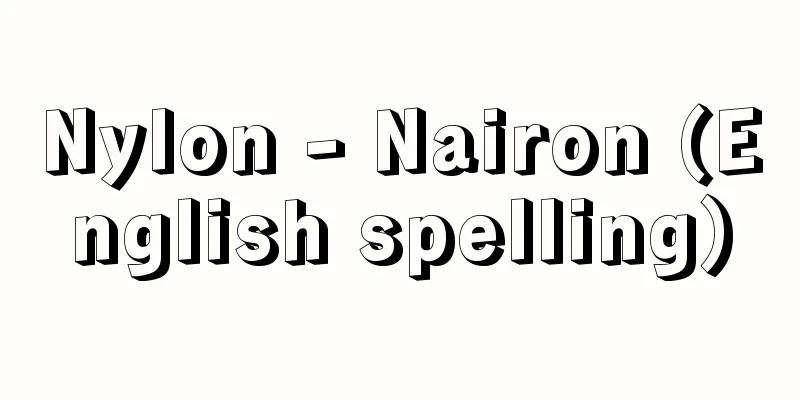Nylon - Nairon (English spelling)

|
It was the product name of a synthetic fiber invented by the American W. H. Carothers in 1935, but now it is a general term for synthetic polymer polyamides that have the property of being formed into fibers. In 1939, it was released by the American chemical company DuPont as the world's first full-scale synthetic fiber. Polyamides are classified into aliphatic, aromatic, and alicyclic polyamides. All of them are linear polymers linked by amide bonds. The thread had a luster similar to that of raw silk and was much stronger. As a result, nylon began to be used to make women's socks (stockings), which had previously been made from raw silk, and Japan's exports of raw silk, which had been the largest in the world before World War II, dropped sharply. Today, nylon is one of the main synthetic fibers, along with polyester and acrylic fibers. [Hiroshi Kakiuchi] Origin of the name "nylon"It is unclear why it was called nylon, but it was originally called Norun. However, this was difficult to pronounce, so it seems to have been changed to Nylon. It is commonly said that nylon itself was the name given to a cream puff in England in 1850, but there is also a theory that it is an acronym of "Now you lousy old Nipponese!" or "Now look out Nippon," which are said to have proclaimed the expulsion of silk from Japan by this fiber, but neither theory is conclusive. In The Discovery of Nylon, Imoto Minoru (1908-99) states the theory that Carothers himself coined the word from nihil (nothingness). [Hiroshi Kakiuchi] Synthesis and typesThe product name "nylon" is also used as the chemical name in honor of Carothers' achievement, but there are more than several hundred linear polymer aliphatic polyamides. Currently, there are mainly two types of synthetic fibers commercially available. One is nylon 6,6 (6,6-nylon), which was first sold by DuPont. The "6,6" indicates that the two constituent molecules of the aliphatic compound bonded by amide groups each have six carbon atoms. The other is nylon 6 (6-nylon). [Hiroshi Kakiuchi] Nylon 6,6Mixing equal moles of adipic acid and hexamethylenediamine in alcohol or water as a solvent produces nylon 6,6 salt (melting point 183-184°C), NH 3 ⊕(CH 2 ) 6 NHOC(CH 2 ) 4 COO ⊖. This salt solution is heated and dehydrated to cause polycondensation (a reaction that produces polymeric substances from low molecular weight substances through repeated condensation), and in the molten state it is used in a spinning machine to produce threads, which are then spun into yarn. [Hiroshi Kakiuchi] Nylon 6Nylon 6 (6-nylon), which has been industrialized in many countries outside the United States, was invented in 1938 by P. Schlack of the German chemical company BASF and commercialized in 1943. Its manufacturing process starts with the cyclic amide caprolactam, which also uses benzene as a raw material. Nylon 6,6 and 6 have similar fiber properties, except for the order of the amide groups. The only difference is the melting point, 250°C for 6,6 and 215°C for 6. [Hiroshi Kakiuchi] Other nylonsThere are many types of nylon other than nylon 6,6 and nylon 6, but one that has been put to practical use is Rilsan, which is industrialized in France. This is nylon 11 (11-nylon) made from aminoundecanoic acid derived from castor oil. In 1988, nylon 6,12 (6,12-nylon) made from hexamethylenediamine and dodecanedioic acid has been produced in the United States for use as monofilament and socks. [Hiroshi Kakiuchi] Nylon performance and applicationsNylon is generally strong, oil-resistant, and chemical-resistant, and can be used stably over a wide range of temperatures from very high to very low. Nylon plastic (nylon that is not spun) is a typical example of an engineering plastic. It has a particularly low coefficient of friction and excellent abrasion resistance, so it is used in machine parts such as silent gears, cams, and bearings in high-end office supplies such as typewriters, building material parts such as pulleys and door rollers, and fasteners. Nylon 6 is also used as a film to package oily and frozen foods, taking advantage of its characteristics of strength, oxygen barrier properties, and oil resistance. Nylon 6,6 film has excellent heat resistance. Nylon fiber has the following properties: high tensile strength, low modulus of elasticity, low water absorption, high abrasion resistance, and ability to be permanently set, and is widely used in knitted and woven fabrics and artificial hair. Due to its high tensile strength, it is used exclusively in very thin woven structures, especially women's hosiery. It is also widely used in blends with wool, cotton, or rayon. Since the late 1960s, aromatic polyamides (aramids) have been attracting attention as a new type of polyamide. [Hiroshi Kakiuchi] "Nylon and Tetoron" by Mizutani Hisakazu (1958, Sangyo Tosho) ▽ "The Discovery of Nylon" by Imoto Minoru (1982, Tokyo Kagaku Dojin) ▽ "'Things' and 'People' Series 7: Plastics" edited by Uchida Yasuzo (1986, Froebel-kan) ▽ "Engineering Plastics" by Kataoka Toshiro et al. (1987, Kyoritsu Shuppan) ▽ "Polyamide Resin Handbook" edited by Fukumoto Osamu (1988, Nikkan Kogyo Shimbun) ▽ "Chemical Demonstrations for Teachers 1: Thermochemistry and Polymers" by Bassam Z. Shakhashiri, translated by Ikemoto Isao (1997, Maruzen) ▽ "Commodity Studies of the Naphtha System" by Moriya Haruo (1997, Moriyama Shoten) ▽ "People Who Opened the Century of Science" edited by Takeuchi Hitoshi, Vol. 2 (1999, Newton Press) ▽ "Showa History of Technological Development by Masanori Moriya (Asahi Bunko)" [Reference] | | | | | | | | | | | | | | | |©Shogakukan "> Manufacturing method and structure of nylon 6,6 ©Shogakukan "> Manufacturing method and structure of nylon 6 Source: Shogakukan Encyclopedia Nipponica About Encyclopedia Nipponica Information | Legend |
|
1935年、アメリカのW・H・カロザースによって発明された合成繊維の商品名であったが、現在では繊維を形づくる性質をもった合成高分子ポリアミドの総称になっている。1939年、アメリカの化学会社デュポンから世界最初の本格的合成繊維として発売された。ポリアミドは脂肪族、芳香族、脂環式ポリアミドに分類される。いずれもアミド結合で連なった線状の高分子である。 糸は生糸によく似た光沢をもち、生糸よりずっとじょうぶであった。そのため、それまで生糸から加工されていた女性用靴下(ストッキング)にナイロンが用いられるようになり、第二次世界大戦前には生産高世界一であった日本の生糸の輸出は激減した。現在、ポリエステル、アクリル繊維とともに合成繊維の主力を占めている。 [垣内 弘] ナイロン命名の由来なぜナイロンとよんだかは不明だが、初めはNorunとした。しかしこれは発音がむずかしいというのでNylonとしたようである。Nylonそのものは、1850年にイギリスのシュークリームにつけられた名称であったと、一般に伝えられている、この繊維による日本からの絹の追放を宣言したという「Now you lousy old Nipponese !」や「Now look out Nippon」の頭文字であるという説も、いずれも確かなものではない。井本稔(みのる)(1908―99)は『ナイロンの発見』のなかで、カロザース自身がnihil(虚無)から造語したという説を述べている。 [垣内 弘] 合成と種類ナイロンという商品名が、カロザースの功績をたたえ化学名としても用いられているが、線状高分子の脂肪族ポリアミドの数は数百以上にもなる。現在、合成繊維として商品化されているものは主として2種類で、一つはデュポン社が最初に発売したナイロン6,6(6,6-ナイロン)である。この6,6という意味はアミド基で結合している脂肪族化合物2種類の構成分子が、いずれも炭素数6個ということを示している。いま一つは、ナイロン6(6-ナイロン)である。 [垣内 弘] ナイロン6,6アジピン酸とヘキサメチレンジアミンの等モルをアルコールまたは水を溶媒として混合すると、ナイロン6,6塩(融点183~184℃)NH3⊕(CH2)6NHOC(CH2)4COO⊖を生成する。この塩水溶液を加熱脱水して重縮合(縮合の繰り返しによって低分子物質から高分子物質を生成させる反応をいう)させていき、溶融状態で紡糸機で糸を引き出す溶融紡糸を行う。 [垣内 弘] ナイロン6アメリカ以外の多くの国で工業化されているものはナイロン6(6-ナイロン)で、これはドイツの化学会社BASFのシュラックP. Schlackによって1938年に発明され、1943年に商品化されたもので、製法としては環状アミドのカプロラクタムからスタートする。カプロラクタムの製造法は、やはりベンゼンを原料としている。 ナイロン6,6と6とはアミド基の配列の順序が変わるだけで、繊維としての諸性質はよく似ている。融点だけは6,6が250℃、6は215℃と異なる。 [垣内 弘] その他のナイロンナイロン6,6とナイロン6以外にもナイロンの種類は数多いが、実用化しているものにフランスで工業化されているリルサンRilsanがある。これは、ひまし油からのアミノウンデカンサン酸を原料としたナイロン11(11-ナイロン)である。また1988年、ヘキサメチレンジアミンとドデカンジオン酸からつくられたナイロン6,12(6,12-ナイロン)は、単繊維および靴下用にアメリカで生産されている。 [垣内 弘] ナイロンの性能と用途ナイロンは一般に強靭(きょうじん)で、耐油性、耐薬品性に優れ、かなりの高温から低温にわたって安定して使用できる。ナイロンプラスチック(紡糸しないナイロン)はエンジニアリング・プラスチックとして代表的なものである。とくに摩擦係数が小さく、耐摩耗性に優れているので、タイプライターなど高級事務用品の無音歯車、カム、ベアリングなどの機械部品や、滑車、戸車などの建材部品、ファスナーなどに使われている。また、ナイロン6はフィルムとして強靭性、酸素遮断性、耐油性に優れている特徴を生かして油性食品や冷凍食品の包装に用いられる。ナイロン6,6のフィルムは耐熱性に優れる。 ナイロン繊維は次の特性、すなわち高い引張り強さ、低い弾性率、低い吸水率、高い耐摩耗性、パーマネントセットができる能力などをもち、編物、織物、人工毛髪として広く用いられている。引張り強さが高いために、非常に薄い織物構造、とくに女性用靴下に独占的な用途をもっている。さらに、羊毛あるいは木綿やレーヨンと混紡することによって広範囲に利用されている。また、1960年代後半以降、芳香族ポリアミド(アラミドaramid)が新しいポリアミドとして脚光を浴びている。 [垣内 弘] 『水谷久一著『ナイロンとテトロン』(1958・産業図書)』▽『井本稔著『ナイロンの発見』(1982・東京化学同人)』▽『内田安三監修『「もの」と「ひと」シリーズ7 プラスチック』(1986・フレーベル館)』▽『片岡俊郎ほか著『エンジニアリングプラスチック』(1987・共立出版)』▽『福本修編『ポリアミド樹脂ハンドブック』(1988・日刊工業新聞社)』▽『Bassam Z. Shakhashiri著、池本勲訳『教師のためのケミカルデモンストレーション1 熱化学・高分子』(1997・丸善)』▽『守屋晴雄著『ナフサ体系の商品学』(1997・森山書店)』▽『竹内均編『科学の世紀を開いた人々』下(1999・ニュートンプレス)』▽『森谷正規著『技術開発の昭和史』(朝日文庫)』 [参照項目] | | | | | | | | | | | | | | | |©Shogakukan"> ナイロン6,6の製造法と構造 ©Shogakukan"> ナイロン6の製造法と構造 出典 小学館 日本大百科全書(ニッポニカ)日本大百科全書(ニッポニカ)について 情報 | 凡例 |
<<: Lago Nahuel Huapí (English spelling)
>>: Nairobi - Nairobi (English spelling)
Recommend
Emile-Antoine Bourdell
French sculptor. Born in Montauban. From the age ...
"Ezo dialect Moshiogusa" - Ezo hogen shiogusa
...The editor, Kumajiro Uehara, was an Ezo interp...
Bitter cress
...It is widely distributed in the Northern Hemis...
Mount Hiko - Hikosan
This volcano lies on the border between Soeda Tow...
Storeroom - Nando
A room in a house where items that are rarely use...
Taborites - Tabor is (English spelling) Táborité [Chieko]
A radical faction of the Hussites who rebelled aga...
Mantis Shrimp - Mantis Shrimp
In a broad sense, it is used as a general term for...
Chernigov
The capital of Chernigov Oblast in northern Ukrai...
Paulus Diaconus (English spelling)
…It is also worth noting that England had two poe...
Freiburg - Freiburg (English spelling) Freiburg im Breisgau
A city in the state of Baden-Württemberg in south...
Kiso Fukushima [town] - Kiso Fukushima
A former town in Kiso County, southwestern Nagano ...
Rhovyl (English spelling)
A fiber made of pure polyvinyl chloride. Trademark...
Parathion - Parachion (English spelling)
The international standard name for the chemical ...
Reichskammergricht
...Therefore, the empire had no potential for dev...
Government bonds
Broadly speaking, it refers to debt of the public...









